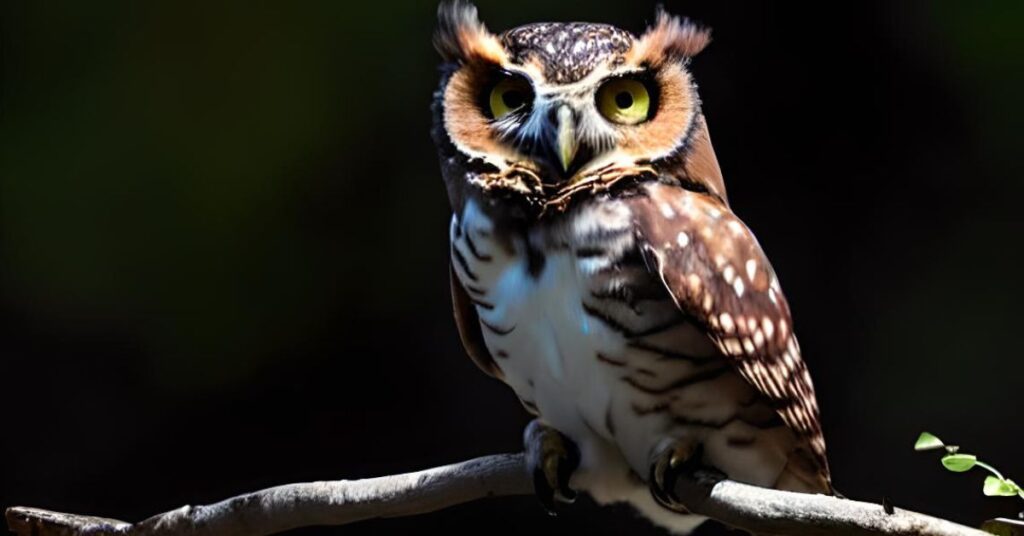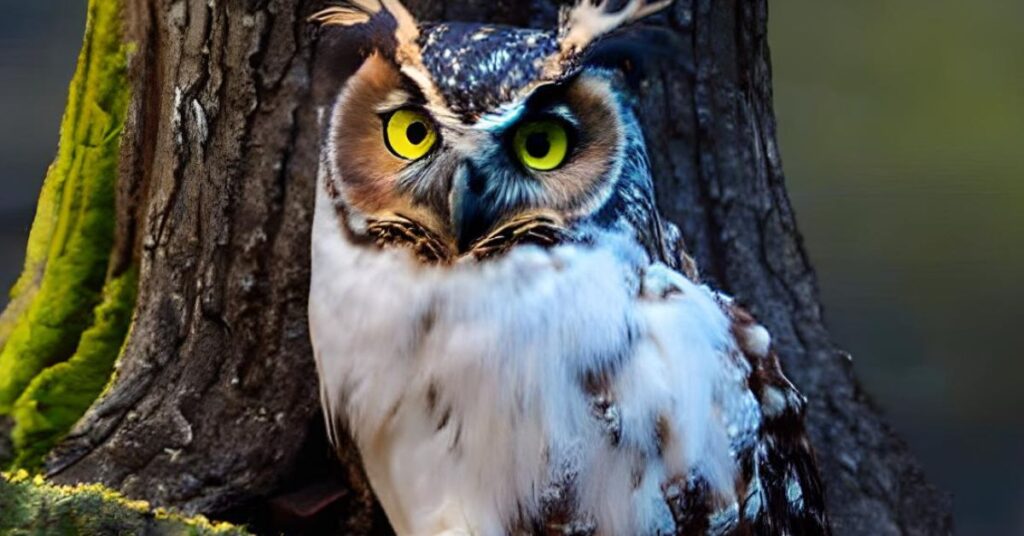Have you bothered to ask why Owls are Associated with Halloween? Because of their nighttime activity and mysterious nature, owls are associated with Halloween. They were thought to communicate with spirits in ancient times, making them symbols of wisdom and the supernatural. The haunting hoots and silent flight add an eerie element to the spooky atmosphere of Halloween traditions.
When the Halloween season approaches, you often notice the prevalence of owls in decorations, costumes, and various spooky representations.
The connection between owls and Halloween has intrigued many individuals, leading to the question: why are owls associated with Halloween?
In this article, I will explore the symbolic history of owls, their connection to Halloween, their nocturnal habits, and their presence in literature and popular culture.
Click here to learn the spiritual meaning of an Owl.
Let’s get started!
Why are Owls Associated with Halloween?

Owls are associated with Halloween for a number of reasons, including:
- Their nocturnal habits. Owls are nocturnal predators, meaning they are most active at night. This gives them a mysterious and otherworldly appearance, while also connecting them to the darkness of Halloween.
- Their appearance. Owls have large, expressive eyes, sharp beaks, and silent flight, which can be all be quite spooky. Their appearance also makes them seem wise and intelligent, which can add to their appeal for some people.
- Their association with death. In some cultures, owls are seen as omens of death or misfortune. This is most likely due to their nocturnal habits and their silent flight, which can make them seem like harbingers of the unknown.
- Their association with witches. In many stories and legends, owls are portrayed as the companions of witches. This association may have originated from the fact that owls are often seen at night, when witches are said to be active.
- Their presence in popular culture. Owls have been featured in many popular books, movies, and TV shows, often in a Halloween-themed context. Many people’s associations with the holiday have been strengthened as a result of this.
It’s worth noting that not all cultures associate owls with Halloween or bad things. Owls are famous for being symbols of wisdom, knowledge, and good luck in some cultures. However, the association between owls and Halloween is strong in many parts of the world and is likely to persist for many years.
The Symbolic History of Owls
Owls have held symbolic significance in various cultures throughout history. To understand their association with Halloween, we must delve into ancient Greek and Roman mythology, Native American beliefs, and European folklore.
In ancient Greece and Rome, owls were associated with wisdom and knowledge. The Greek goddess Athena, renowned for her wisdom, was always depicted with an owl perched on her shoulder. The Romans viewed owls as omens of impending doom or death.
Native American tribes, such as the Apache and Hopi, associated owls with protection and wisdom. They believed that owls possessed the power to ward off evil spirits and brings divine fortune. Additionally, some tribes believed owls were messengers between the living and the spirit world.
European folklore portrayed owls as creatures of both wisdom and darkness. They were considered to be companions of witches and harbingers of death. Owls were commonly associated with supernatural events and were believed to possess magical powers.
The Connection to Halloween

The roots of owls’ association with Halloween can be traced back to the ancient beliefs and superstitions surrounding these creatures. Halloween, originally known as Samhain, was a Celtic festival celebrating the coming to anend of harvest season and the start of winter.
During Samhain, it was believed that spirits roamed the Earth, and various creatures, including owls, were considered to be their familiars or companions. Owls were seen as guardians, protecting individuals from evil spirits during this mystical time.
As Halloween evolved over time, owls retained their connection to the supernatural and became synonymous with the eerie atmosphere of the holiday. Their mysterious and haunting presence perfectly aligns with the overall theme of Halloween.
Nocturnal Habits and Mysterious Persona
The nocturnal habits of owls further contribute to their association with Halloween. Owls are classified as nocturnal birds of prey, which means they are most active at night. Their ability to see through and hunt in the darkness adds to their enigmatic aura.
Owls have excellent night vision and acute hearing, making them highly adaptable to their nighttime environment. Their silent flight and piercing gaze have captivated human imagination for centuries, evoking a sense of mystique and the unknown.
Halloween Decorations and Imagery
One cannot ignore the prevalence of owls in Halloween decorations and imagery. Whether it’s a spooky owl figurine, a haunting owl mask, or owl-shaped lights, these representations create a haunting ambiance associated with the holiday.
The owl’s appearance, with its large, intense eyes and sharp beak, lends itself well to Halloween themes. Its association with darkness and mystery aligns perfectly with the eerie atmosphere that people seek during the Halloween season.
Owls as Familiars and Witch’s Companions

In many depictions of witches, owls are portrayed as their companions or familiars. This association can be attributed to European folk beliefs that witches could transform themselves into owls or communicate with them. The depiction of witches with owls has persisted throughout history and remains a popular image in contemporary culture.
Popular culture, such as movies and books, has further cemented the connection between witches and owls. The Harry Potter series features a snowy white owl named Hedwig, who serves as the loyal companion to the main character, Harry Potter. This portrayal has solidified the image of owls as mystical and magical creatures in the minds of many.
Owls in Literature and Entertainment
Owls have often made appearances in literature and entertainment, heightening their association with Halloween. One notable example is Washington Irving’s “The Legend of Sleepy Hollow.” In this tale, the headless horseman is said to be accompanied by an eerie owl, emphasizing the spooky atmosphere of the story.
In conclusion, owls have become deeply intertwined with Halloween due to their historical symbolism, nocturnal habits, and mysterious attributes.
Their association with witches, supernatural themes, and their prevalence in Halloween decorations further solidifies this connection.
Owls’ enigmatic nature and presence in various forms of entertainment make them an integral part of the Halloween experience. So, the next time you spot an owl during the Halloween season, remember its fascinating history and the reasons behind its association with this spooky holiday.
Conclusion
Owls have captivated human imagination for ages, and their association with Halloween is deeply rooted in ancient beliefs, folklore, and superstitions.
From their symbolic significance in ancient Greek and Roman mythology to their portrayal as companions of witches and messengers between worlds, owls have woven their way into Halloween traditions.
Their nocturnal habits, mysterious persona, and prevalence in Halloween decorations further solidify their connection to this celebrated holiday.
Whether you encounter an owl figurine or read about these creatures in literature or entertainment, they continue to symbolize the enigmatic spirit of Halloween.
I hope this article is helpful. If so, consider subscribing to my newsletters for updates.
Click here to find out if Owls bring bad luck or not.
FAQs
1. Are owls considered evil or bad luck?
While owls are often associated with mystery and darkness, they are not inherently considered evil or bad luck in most cultures. Many civilizations throughout history have regarded owls as symbols of wisdom, protection, or favored omens.
2. Why do owls appear in Halloween decorations?
Owls’ appearance in Halloween decorations is largely due to their association with the supernatural and their mysterious qualities. Their haunting gaze and connection to witches make them a fitting addition to the Halloween aesthetic.
3. Can owls really turn their heads 360 degrees?
Yes, owls possess the unique ability to rotate their heads up to 270 degrees in each direction due to their flexible neck vertebrae. This extraordinary range of motion helps them scan their surroundings and locate prey.
4. What are the most common owl species associated with Halloween?
The most commonly associated owl species with Halloween are the Barn Owl, the Great Horned Owl, and the Snowy Owl. These species have distinct appearances and possess the characteristics often associated with Halloween.
5. Do other cultures have different associations with owls and Halloween?
Yes, different cultures may have their own unique associations with owls and Halloween. For example, some Asian cultures believe that owls are symbols of luck and protection, while others may view them as omens of death or impending doom.

